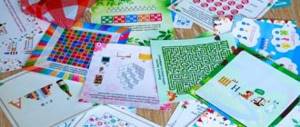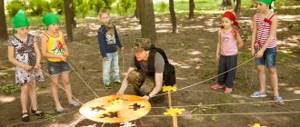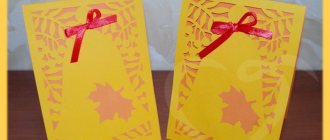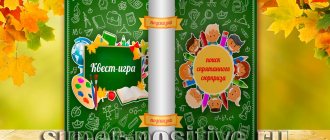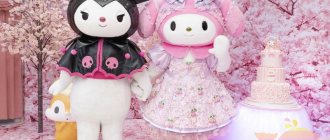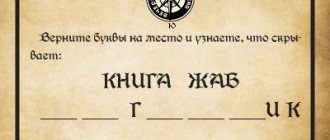Description of tasks and quest design
If you wish, you can start the quest by handing over a letter from Captain John Howard (included with the quest).
The letter can be printed, rolled up and placed in a bottle of rum or wine, leaving the edge outside so that you can actually get it out. Then give it to the participants. Or simply give the letter, and after reading, hand over the first task (hint).
The adventure game consists of 10 stages (chapters). They have a strict sequence.
Here's what the printed assignments look like.
Descriptions of tasks and code words that need to be guessed - they indicate the places where the next clues are hidden.
| Tasks (tips) | Code words (answers) | |
| 1 | We are packing for sailing . Crossword on a pirate theme. The difficult level uses a verbal description of the hidden words, and the easy level uses pictures. | Cushion, stool, nightstand |
| 2 | We are recruiting a team . Based on the description, choose the correct pirates + anagram in the complex version. | Album, magazine |
| 3 | In the sea. Find the differences in the pictures. | Option 1: window sill, vase, chair. Option 2: painting, fruit, flower pot |
| 4 | Treasure map. Put the puzzle together. | Kettle, briefcase |
| 5 | Enemy ship. Count the enemy forces on the other pirate ship (men, cannons, gunpowder, cannonballs). | Bread, watch |
| 6 | Sea battle. Strike an enemy ship at the given coordinates. | Decanter, umbrella |
| 7 | Repairing the ship. Find all damaged parts of the ship. | Dictionary, poster |
| 7 | On the way to the island. Complete the maze + anagram in the difficult version. | Pan, battery |
| 9 | Gifts to the gods of the island . Find words that combine groups of pictures. | Envelope, diary |
| 10 | Treasures are just a stone's throw away . Puzzle. | Box, hanger |
How to order and conduct.
The quest is a set of pictures with an introductory letter from the captain and 4 PDF files (opened through any Internet browser): easy version tasks on 23 pages, difficult version tasks on 23 pages, answers on 5 pages and instructions on 4 pages.
After payment, the quest materials are sent to your email inbox.
You will have to print the assignments yourself on a color or black and white printer.
Assignment - the puzzle will need to be cut with scissors along the existing lines or into pieces of any shape at your discretion.
Place the printed clues into hiding places and you can begin. More detailed instructions and tips are available in the quest materials.
The goal is to promote the development of the imagination of preschoolers, using modern non-traditional methods and techniques, game quest technologies, “Step by Step” technologies/methodologies that promote the formation of independent thinking in children, the development of imagination and cognitive activity. Objectives: - educational - to consolidate children’s ideas about vegetables and fruits, their places of growth; counting to ten, geometric shapes, colors.
— developmental — broaden one’s horizons — educational — cultivate independence in completing tasks and be responsible for the answers. Methods and techniques: - practical (games “Name the number in English”, “Collect vegetables and fruits”, “What fairy tale?”); — visual (slides with tasks); - verbal (discussion, children's stories, questions). Materials and equipment: projector, screen, slides with “In Search of Treasures” tasks, shadow pictures of fairy tales, envelopes according to the number of children with math cards (numbers in red and blue), felt flowers, cards with images of fruits and vegetables, two pots, blue and yellow ties, a flower meadow, two tables with math cards, two tables with vegetables and fruits. Progress of the quest Educator: Guys, do you like to play games? Children: Yes! Educator: Do you want to play now? (1 slide appears on the screen with a picture of a chest) What do you think this game is about? (children make assumptions). What do you think we will do? Children: Look for treasures! The teacher and the children approach the table on which the card lies. Educator: Here is a map by which we can find our treasures. But it's empty! In order to find the treasure, we need to collect stars! Begin?! Children: Yes! (pronounce the words) Children: We are all going, we are all going. Treasures are waiting for us. We will complete all the tasks, and our treasure is right there! Follow the arrows to the first task! “Visiting a fairy tale” - music sounds “Visiting a fairy tale” Educator: - And here is the first task - To find treasures, we need to complete tasks! Guess from the pictures what fairy tale?! Educator: - Well done guys, you are making great progress! And here is your first star! Pin it to your map! Do you see these traces?! They will lead us to the next task! “Vegetable Garden Screensaver”. Offers the children the game “Collect vegetables and fruits” (music) Educator: The tracks led us to the garden. Those children with yellow ties pick fruits, and those children with green ties pick vegetables! Children are divided into two teams and put vegetables and fruits in their baskets. But that is not all! Those who collected vegetables will name them in Kazakh, those who collected fruits in English. Educator: Great! You have a second star! Educator: - Well done guys! How many fruits and vegetables have you collected?! Children: - 10! Educator: Let's solve the problems! — Vova had 10 bananas. Vova gave three bananas to Kirill. How many bananas does he have left? Children: 7! — Arina bought 4 heads of cabbage, Amalia bought 3 heads of cabbage. How many heads of cabbage do girls have? Children: 7! Educator: And you earned the third star! Kirill and Amalia pin the stars on the map! And we moved on! Look at this suspension bridge! (children move along a rope) (They approach the table with tasks!) Educator: - Guess the riddle: There was a magical forest all around. There's a sweet house in the clearing. The door is open, treats are on the table and singing is heard in the morning! Who lives there? Blue-eyed, white-faced - Like a sister to the dwarf brothers. This fairy tale is familiar to everyone (Snow White and the 7 Dwarfs). A slide with a picture from the cartoon “Snow White and the Seven Dwarfs” is displayed. Educator: What other fairy tales do you remember in which there is the number 7? Children: A wolf and seven kids. Seven-flowered flower. Educator:
— You are doing an excellent job and received the fourth star! Kamalia pin the star on the map! And now we need to find this fairy tale in our hall. Do you see these colored circles? Let's follow them! (children with a teacher go through the colored circles and find a book, and in it an envelope with assignments).
“Flower Meadow” Educator:
- All obstacles are not scary if you know languages! Look, we have a “Flower Meadow”, but there are no flowers on it! Let's decorate it! We need to plant flowers and name their colors in English. (The guys plant flowers, name their colors in English. (white, pink, green, yellow, red, brown, blue, black)) Educator: Well done guys! You have completed the next task and receive a fifth star. Sabina, pin the star on the map. And we continue! For the next task you need to go over the bumps. (To the hoops) Children: We are all going, we are all going. Treasures are waiting for us. We will complete all the tasks, and our treasure is right there! Slide “Funny numbers” - music sounds. Next task “Mathematical Kaleidoscope” Educator: - Guys, we are almost there, the last task remains. There are cards with numbers on the mat. You need to expand the number series from 1 to 10. Guys with green ties, name the blue numbers in English! Guys with yellow ties, say the red numbers in German. Well done, you have the sixth star! Look at the screen! A picture appears on the screen with a part of the hall where the treasures are hidden. Educator: - What does this mean? Looks like our treasures are hidden there! (Children find gifts). Slide - a map with stars opens, under them there is a photo of the hall where the treasure chest is hidden. 2-3 children go for the chest, bring it and open it. The chest contains sweet treasures - chocolates, mixed with beads, etc. Victory music sounds. The teacher conducts an analysis: - Guys, what did you do in organized learning activities? -Were the tasks difficult? -Did you like the game? End of the quest.
To whom, where and on what occasion will a quest be appropriate.
The quest tasks are designed for children from 8 to 14 years old. But this is the recommended age. If desired, adults can also participate. Some clues will be even more difficult for them to guess than for children.
Most tasks are designed in two difficulty levels. This way you can select tasks that are optimal in difficulty based on the age of the players.
The quest itself is about finding treasures. This makes it the perfect multi-stage competition for a pirate party.
But you don’t have to get attached to the pirate theme. It is appropriate to conduct a quest at any birthday, party, New Year or other holiday.
The tasks (tips) of the quest are designed so that it can be organized in any apartment, house, school or cafe.
There are 3 methods available:
- Walking alone. This way you can give a gift to a little birthday boy or a fully grown loved one.
- Group passage. Participants solve puzzles together, step by step approaching the treasured “treasures”.
- Team competition. All hints have two options: the tasks are the same, but the key places (hides) are different. Teams solve clues parallel to each other, trying to get ahead of their opponents and be the first to find the “treasure”.
